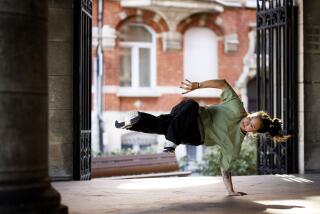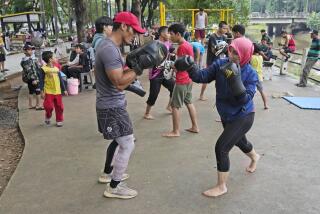Sure, the action and yelling are part of the draw. But when it comes to martial arts, instilling discipline and teaching kids to walk away from fights are the real . . . : Kick Backs
WASHINGTON — “ Jun Bi! “
The voice barks the “ready” command in Korean, and several dozen small bodies stiffen, their arms straight out at a slight downward angle, hands in fists, bare feet apart, toes up.
The line is resplendent in white, the bleached brightness of each gi punctuated only by a sash of color at the waist. Belt colors denote rank: the higher-level browns stand in the most honored place at the far right end of the line. Beginners, all in white, are to the left. Everyone else, in ascending order of rank, is in between: orange, yellow, red, green, purple and blue. The instructor wears the only black belt in the room.
It’s Tuesday, 7 p.m., in Westbrook Elementary School in Bethesda, Md. The weekly children’s karate class, sponsored by Tompkins Karate Assn., has begun.
The children range in age from 5 to 12. The room is packed. The children and their instructor, Ken Krulik, already have “bowed” in, a brief ceremonial sign of mutual respect that begins and closes every session.
For the next hour, they will kick, punch, block, yell and engage in highly disciplined exercises that simulate combat. And the kids will love it.
Janet Sobel is among the parents sitting in the back of the room. Many of the parents have brought books or magazines to pass the time, or are chatting among themselves. Sobel is not one of them.
She is rapt, watching intently, both anxious and curious. Her 7-year-old son, Ross Nachbi, is here for the first time, and she listens carefully to Krulik as he works with the beginners.
Sobel’s children--she also has a daughter, almost 5--do not know about Teenage Mutant Ninja Turtles or Mighty Morphin Power Rangers. They are not allowed to watch violent television shows or movies that promote themes of violence. Sobel tries to teach her children about peaceful resolutions. One basic underpinning of her philosophy as a parent is that violence is a bad thing and should be shunned.
So why is she here watching as Krulik teaches her son how to engage in behavior that can only be described as violent? And why has she spent many evenings like this in recent months visiting countless other martial arts classes searching for the perfect one for her children?
Because Sobel, like many parents and experts in recent years, has begun to recognize that the values and discipline inherent in all martial arts training can, if taught properly, contribute toward building children’s self-confidence and self-esteem, respect for others and for themselves--and can help them resist the forces of violence.
“There is a kind of centering--a grounding--that they find within themselves, and they will begin to transmit a certain air,” Sobel says. “They present themselves differently as a result of that inner confidence. That’s what power is, and where it comes from. I don’t want my children ever to have to use what they learn in martial arts. I want them to be able to walk away from violent confrontations in a position of strength. I think martial arts knowledge enables them to walk away.”
There are no national statistics on the numbers of children taking up the countless styles and disciplines of martial arts. Nevertheless, by all anecdotal accounts, this martial arts training appears to be growing steadily in popularity, for the very reasons articulated by Sobel. And they are not confined to the affluent suburbs. Youth programs also have sprung up in cities as a strong part an of anti-violence strategy.
“One of the things we do in martial arts is to give young people the kind of inner strength and inner development to feel comfortable walking away from a violent confrontation,” says Geoffrey Canada, president of the Harlem-based Rheedlen Centers for Children and Families in New York City.
“In walking away, they don’t diminish the certainty of their bravery and courage,” he adds. “Martial arts helps children learn to find that place within themselves to resist the outside taunts and jeers of peers and friends who tease them because they won’t fight or act violently.”
*
Martial arts is an umbrella term used to describe a diverse group of activities that have evolved over centuries from ancient Asian fighting skills. Today, the martial arts represent numerous and different concepts, styles, techniques, forms and procedures, everything from the graceful, slow movements of tai chi to the holds, locks and grappling of jujitsu.
Some disciplines employ a mix of systems, among them kata, or forms, which are rigid prearranged action sequences that mimic combat and performed as training exercises; free sparring, or fighting, which uses fist blows, blocks and parries, but emphasizes control by requiring no actual contact, and jujitsu, which involves wrist locks, takedowns and other throws, and the use of nerve centers and pressure points as targets.
Canada, writing in a new book about violence in America, “Fist Stick Knife Gun” (Beacon Press), explains why he insisted on creating a martial arts program at Rheedlen. Canada, a black belt in tae kwon do, has taught martial arts for many years.
“I was convinced that the discipline and values taught in martial arts could help young boys and girls resist that constant peer pressure to fight and act violently,” he writes. “I knew it seemed counter-intuitive that teaching young people how to punch, kick and defend themselves would reduce violence, but I had seen firsthand the peace that many young people had experienced, some for the first time in their lives, after some time spent learning martial arts.”
To be sure, it also is a boon to physical fitness--it enhances flexibility and hand-eye coordination, and conditions the body for other sports. Beyond that, however, martial arts also can bestow a level of mental discipline that can spill into other areas of a child’s life in very positive ways. Experts say, for example, that children engaged in martial arts--where goal-setting toward earning new belts is an integral part--also seem to improve in other activities that require discipline: homework and studying, classroom behavior and exam-taking.
“I had one child in my classes whose father had been transferred a lot, and he’d had a tough time making friends, and he’d been having trouble in school, being disruptive,” says Mitch Maeda, who teaches aikido, a Japanese martial art, in the city of Orange.
“After he enrolled in the program, his parents told me his whole attitude changed. Just the confidence thing did it--he was more disciplined. And he found he didn’t have to be disruptive anymore.”
Canada agrees. “Martial arts brings focus, discipline and commitment,” he says. “A highly skilled martial artist is a highly disciplined individual. It is really difficult to go up in rank if you aren’t disciplined. How does that transfer into other areas of life?”
*
Karate and its variations also can be of special value to children with physical or mental disabilities, experts say. “It’s great for physical coordination and working on motor skills,” Krulik says. “For a child with a disability, it is a great feeling of accomplishment to progress to the next belt level.”
In March, for example, Bobby O’Brien, a 14-year-old from Olney, Md., with Down’s syndrome, earned his junior black belt. He intends to go for his adult black belt once he becomes eligible at 16.
Jim O’Brien, his father, says his son’s years of karate have given him “a tremendous self-image. He feels like a normal kid.”
Although Bobby’s reaction time and mental processing skills are a little slower, “he can aggressively go out and do the combinations” required, and “he knows his techniques very well,” his father says. More important, “he thinks of himself as a cool guy, the way most teen-agers think.”
Most martial arts experts caution, however, that true mastery of the techniques can take years before reaction to an attack is split-second and instinctual. Most martial arts schools encourage students to seek a mind-set where they can avoid using their skills.
“I’ve never been in a fight in my whole life,” says Maeda, who has been studying for 25 years, since he was 10.
But he does remember with amusement that, as a child, he often employed a wrist manipulation technique--which can be extremely painful if taken to its logical conclusion--to retrieve a pencil taken away from him by another child.
Yet, “I never thought of it as a fighting technique,” he says, chuckling. “I always wondered why the other child always was in such pain. I got him crying. But I always got my pencil back.”
More to Read
Go beyond the scoreboard
Get the latest on L.A.'s teams in the daily Sports Report newsletter.
You may occasionally receive promotional content from the Los Angeles Times.










